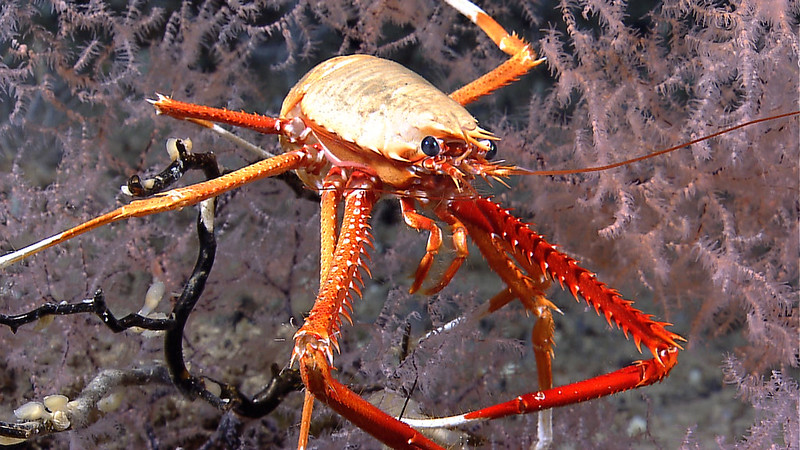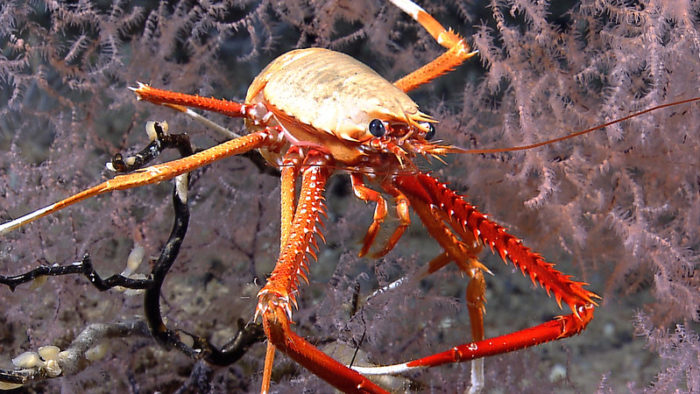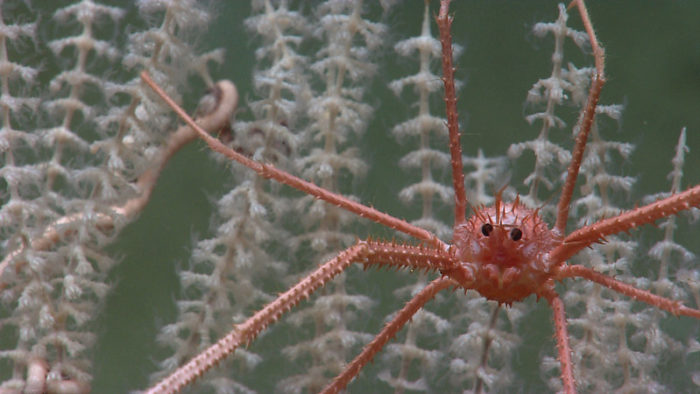
Sea Wonder: Squat Lobster

Photo credit: NOAA Ocean Exploration
What’s in a name? Squat lobsters, despite their name and appearance, are not considered true lobsters. They are more closely related to hermit crabs, though they are not true crabs either. Scientists have documented more than 900 species of squat lobsters, and it is possible that many more species have yet to be discovered.
Description
Squat lobsters don’t need to carry shells on their backs like their hermit crab relatives. Thanks to their flat bodies and small size ranging from 0.7 to 3.5 inches in length, they are able to protect themselves by hiding in crevices and underneath rocks. Their claws are large, sharp, and can grow to be twice as long as their bodies. While concealed in these tight places, squat lobsters leave their claws exposed to defend their space and possibly ambush unsuspecting prey that may swim past. These colorful, ten-legged crustaceans also have long antennae which help them locate surrounding objects and keep their distance from other squat lobsters.
Diet and Habitat
Squat lobsters live throughout the global ocean, except for very cold Arctic and Antarctic waters. Most species dwell in large numbers and are usually found along the deep sea floor in canyons, seamounts, and hydrothermal vents. Juveniles sometimes visit the water column to prey upon blooms of plankton. Some types of squat lobsters can be found throughout the National Marine Sanctuary System. Species that are distributed from Alaska to Baja California may be found in one or more of the West Coast sanctuaries, which include Olympic Coast, Cordell Bank, Greater Farallones, Monterey Bay, and Channel Islands National Marine Sanctuaries.
Squat lobster diets are highly variable because of the great number of species and wide distribution of these creatures. For the most part, squat lobsters are opportunistic feeders that will eat whatever they can find and catch. Their large variety of food sources may include other crustaceans, marine worms, bacteria from hydrothermal vents, plankton, algae particles, and even dead plants and animals. The species M. andamanica exclusively feeds on a diet of driftwood from sources like sunken trees and shipwrecks. To feed, squat lobsters use their claws to scoop up and sift through sand in search of anything edible.
Large fish are the most common natural predator of squat lobsters, though there are others depending on the species and ecosystem. Species living among large corals have been known to steal and eat corals’ protective slime for defense and to spread their pincers to fend off approaching intruders.
Life History
The reproductive behavior of most squat lobster species is not well understood. We know that like other crustaceans, these animals lay eggs that hatch into larvae and proceed to grow into juvenile and adult squat lobsters. While the lifespan of most types of squat lobsters is unknown, some species around the world are estimated to survive between four and eight years.
Threats and Conservation
Though fish are the squat lobster’s most common natural predator, humans consume and make use of these creatures as well. Squat lobsters are not widely fished, possibly because of their small size, but they can be used in seafood dishes, feed stock for chicken and salmon farming, and cheese processing. While squat lobsters currently have a conservation status of “Least Concern,” their populations could be impacted by over-harvesting, a changing climate and ocean, and marine pollution.

Photo credit: NOAA Ocean Exploration
